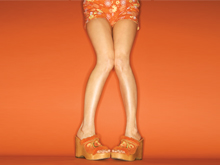Health Topics
-
Healthy Living
-
|
|
August 2011
|
| Bracing Up To Knock-Knees |
| Subodh Samuel |
| |
 |
Though there may not be a sure-shot cure for knock-knees, a number of corrective measures can be of great help… |
Eight-year-old Abhilasha has a problem she can’t hide. When she stands or walks, her knees rub against each other, her legs are angled outward and her feet are too far apart. Though there is no physical discomfort, but it gives her an unnatural gait. Her worried mother, Aruna, knows that the condition has the potential of eroding her self-esteem once she is an adolescent.
A visit to the doctor confirmed that Abhilasha has knock-knees. Though in childhood knock knees are a part of normal growth, but they usually straighten out by the time the child grows up and the legs gain strength. However, if they don’t correct on their own then it would mean a visit to a doctor and a possible line of treatment.
The Causes
knock-knees in grown-up kids could be a result of weak ligaments or bones of the lower legs which cannot support the body weight. As a result the knees come together and the ankles spread apart so that the body can be adequately balanced. Though the problem can strike any child but obese children are more at risk as the legs may find it difficult to support the body weight giving rise to the knock-kneed condition. Severe injury in the shinbone or knee can also result in knock-knees.
Other causes could include certain diseases like scurvy (deficiency of Vitamin C) or rickets which is a disorder that makes bones soft because of a lack of Vitamin D, phosphorous and calcium.
Besides an ungainly gait, a young person with knock-knees could become highly injury-prone, especially when participating in energetic sports like running or skipping because the body balance is skewed. At a later age he or she may develop painful osteoarthritis and in extreme cases there may be a considerable problem in walking.
Dealing With Knock-Knees
If a child’s knock-knees do not straighten out by the time he or she is around eight or nine years old, medical assistance should be sought. According to doctors, though there is no sure-shot permanent cure for the condition, some of the measures would definitely help make the person as normal as possible.
Physical Exercises: Children who show symptoms of knock-knees are put into a special exercise regimen by doctors. These are workouts aimed at strengthening quadriceps, abductors, hamstring and other leg muscles. Though a doctor can best make a workout plan some of the beneficial exercises for knock-knees include lateral lunges, squats and abduction.
Change of Diet: If knock knees are a result of scurvy, then the child should be put on a healthy diet in consultation with a nutritionist. The diet should, in particular, contain a variety of fruits and vegetables. If the problem is rickets then the diet should include fish, liver and milk. A certain amount of exposure to sunlight also helps.
Special Shoes: Children with knock-knees can wear shoes with heel-lift or arch-support, either from the inside or running on the outsole. The special shoes have an inbuilt wedge to correct the position of the legs by straightening the foot. In some cases these orthopaedic shoes can be equipped with an arch pad which also does the job of realigning the legs.
Night Braces: Many orthopaedics recommend the use of braces or splints at night to realign the legs. These braces are particularly beneficial for people who have a family history of knock-knees. The function of a night brace attached to the shoe is to pull the knee upwards into its correct position. At times these braces would have to be custom-made.
Surgery: Recommended only in severe cases, corrective surgery is the last option though not a desirable one unless strongly recommended by a doctor. The procedure involves cutting and correcting the shin bones to bring them into normal shape. However, in the case of adults, doctors usually recommend complete knee replacement to cure knock-knees.
Yoga Exercises: There are some who also recommend special Yoga stretching exercises like Veerbhadrasana, Pavanmuktasana, Trikonasana Salabhasana and Shavasana. However, since no scientific research has gone into the benefits of these asanas for knock-knees, the best course would be to consult a doctor who would asses the problem and recommend a line of treatment. |
|
|